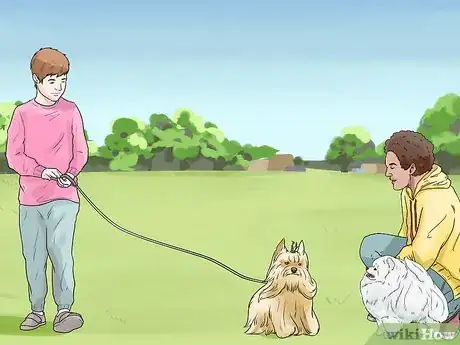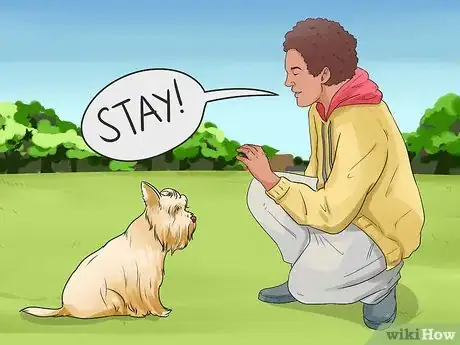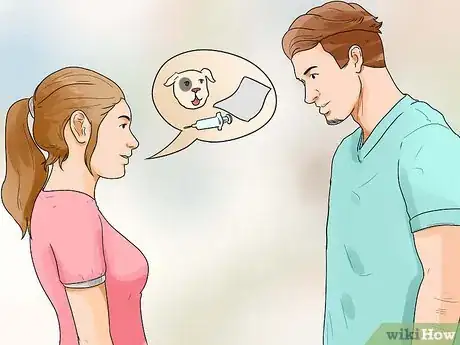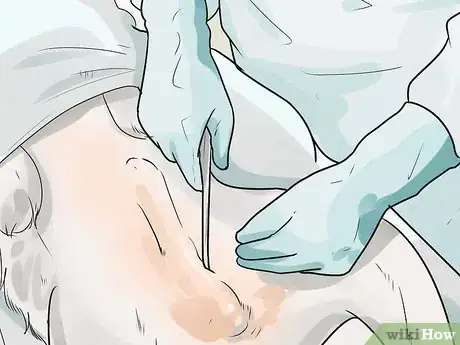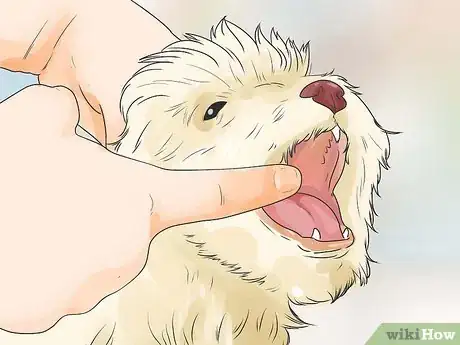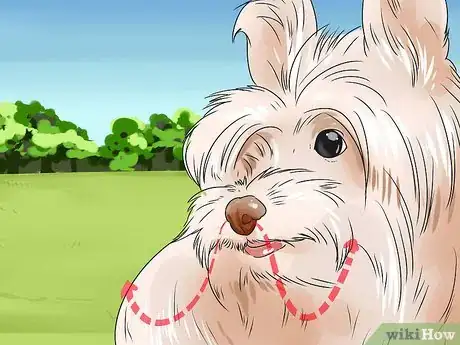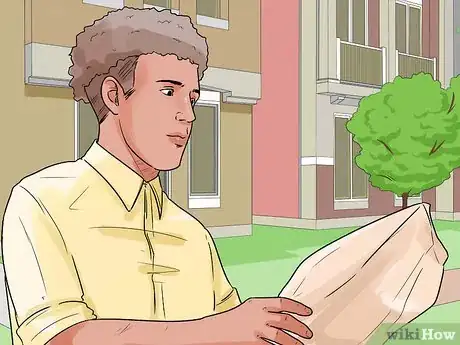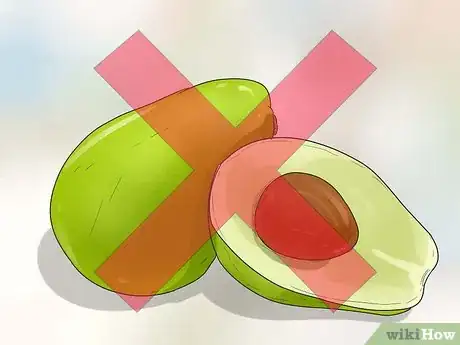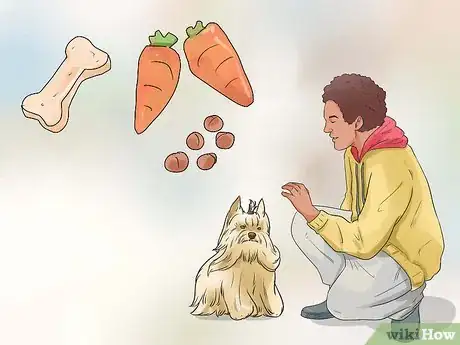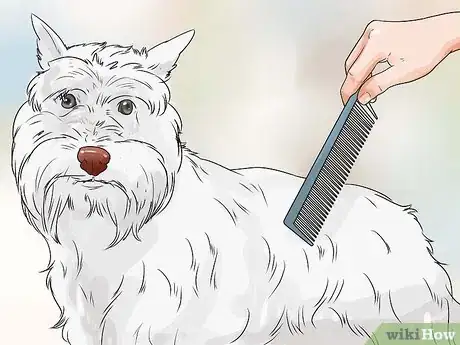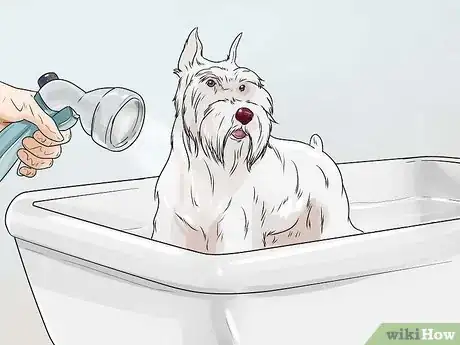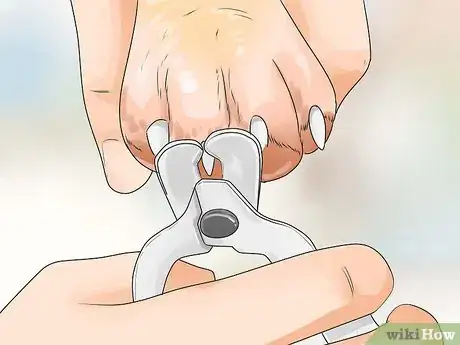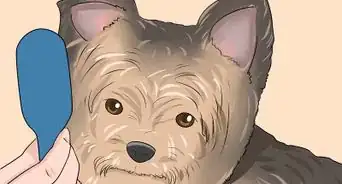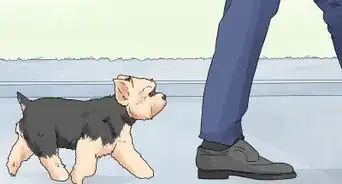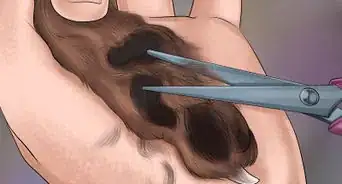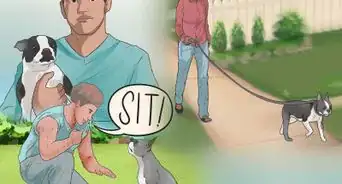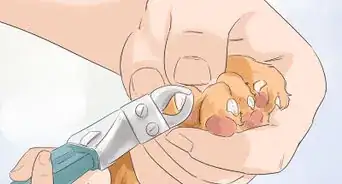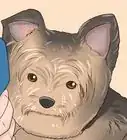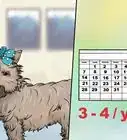This article was co-authored by Amanda Marshall-Polimeni and by wikiHow staff writer, Jessica Gibson. Amanda Marshall-Polimeni is a Dog Behavior Consultant and the Owner/Founder of FurryTales in New Jersey. With a deep understanding of behavioral learning theories and a passion for the physical and psychological well-being of animals, Amanda specializes in using non-coercive, reinforcement-based approaches to generate desired behaviors. Amanda holds a BASc in Applied Psychology from NYU and is a Certified Professional Dog Trainer - Knowledge Assessed (CPDT-KA) and Certified Behavior Consultant Canine (CBCC-KA). She has also completed a Master’s Course in Aggressive Dog Training. Her initiative and dedication to quality, comprehensive animal care at FurryTales led to her recognition by Grow by Acorns + CNBC.
There are 12 references cited in this article, which can be found at the bottom of the page.
wikiHow marks an article as reader-approved once it receives enough positive feedback. In this case, 93% of readers who voted found the article helpful, earning it our reader-approved status.
This article has been viewed 25,905 times.
The Yorkshire Terrier is one of the most recognizable small dogs. The Yorkie, first bred to kill mice and rats, has become a fashionable and loyal pet.[1] [2] This high energy family dog is a great companion for kids, although they need to be careful. The Yorkie's tiny size can make him prone to injury. This tiny size makes him perfect for smaller homes or apartments, especially since he can get his exercise from simply running around the home (although Yorkies love going on walks too). With proper care and attention, your Yorkshire Terrier can have a long and happy life.
Steps
Training Your Yorkshire Terrier
-
1Start training your Yorkie early. Begin training your Yorkie as soon as you bring him home. Devote plenty of time to teaching your dog the house rules (like where you want him to toilet) and any other social rules you want him to follow (like no barking at people). If you can't give plenty of time to training, consider whether you should adopt a Yorkie.
- Many people return their dogs to animal shelters because they don't realize the time, cost, and effort needed to train.
-
2Socialize your dog. Expose him to as many new people, environments, and situations as you can. If you can, take him on car rides, visits to the park, and short walks around the neighborhood. Just make sure that your Yorkie has his first set of vaccines before socializing him.
- Let your dog have a chance to interact with men, women, and children in a positive way so that he's not scared of people.
- Consider enrolling your Yorkie in an obedience training or puppy socializing class. Ask your veterinarian, local pet store, or community class organization to recommend a program.[3]
Advertisement -
3Teach your dog simple commands. Start teaching your Yorkie basic commands like "sit", "stay", or "down". For example, you can teach your dog to sit by making him stand in front of you. When you have his attention, show him a treat between your fingers and hold it just above his head. Gradually move the treat back between his ears and he'll naturally follow it. Command him to "sit" as he begins to sit and immediately reward him, saying "good, sit" simultaneously.
- Train your dog when you have his full attention. If your dog starts to lose interest or is having trouble listening, stop the lesson and try again later.[4]
-
4Use reward-based training. Yorkshire Terriers respond well to positive reinforcement and training. Teach commands by rewarding your dog when he obeys the command or makes positive steps. The reward could be food or verbal praise. Never reward negative behavior or you'll simply reinforce the bad behavior.
- Be consistent in your training. Remember to immediately respond to your dog's behavior so your Yorkie knows what to expect.[5]
Keeping Your Yorkshire Terrier Healthy
-
1Talk with the breeder about early health care. The breeder should have taken your Yorkie to a vet at 6 weeks of age for an exam, his first distemper shot, and a dewormer to kill internal parasites. Ask for a bill or invoice from the vet to prove this was done.[6]
- You should always research the breeder before purchasing a dog.
-
2Get regular veterinary treatments. Your Yorkshire Terrier will need to return to the vet for a second dose of dewormer 2 weeks after his initial visit. This will kill any residual worms. Make sure your dog gets regular veterinary care, including the following vaccines according to this schedule:[7]
- Heartworm preventative at 8 weeks, then once a month during heartworm season (or year round depending upon your veterinarian’s recommendation.)
- Lyme vaccine at 9 weeks, followed by a booster at 12 weeks
- Rabies vaccine at 12 weeks
- Spay or neuter operation at 6 months
- An annual exam and vaccine booster starting at 1 year of age
- Twice yearly examinations starting at 10 years of age
-
3Brush your Yorkshire Terrier's teeth. Put a small dab of dog toothpaste on your finger and let him lick it off. Then, place a little paste on the brush and wipe it along the gums. The next day, brush a little toothpaste along the gums and outer surfaces of the outer teeth. Try to brush more teeth every day, until you're able to brush all the outer surfaces of the teeth.[8]
- You don’t need to try to brush the inner teeth because most plaque attacks the outer teeth.
- Get your Yorkie used to teeth brushing, which is important since they have crowded teeth. These tight spaces are perfect for bacteria and plaque to collect, causing tooth loss and decay.
-
4Get professional dental care. The veterinarian will check your Yorkshire Terrier's teeth at his annual exam. But, you'll still need to take your Yorkie for a professional tooth cleaning to remove bacteria and plaque under the gums even if you brush his teeth daily. Get your Yorkshire Terrier's teeth professionally cleaned at least once a year.[9]
- While you are brushing, check for any sores, loose teeth, or growths in your Yorkie's mouth. If you find any, take your dog to the veterinarian for an examination.
-
5Recognize health problems unique to Yorkshire Terriers. A Yorkie is prone to several health problems because of its small size, especially broken bones. Your bold little dog may try to take on much larger dogs which can lead to injuries. Always keep your Yorkie on a leash and by your side when you take him out. Be aware that your Yorkie may be affected by:[10]
- Patellar (kneecap) luxation: The kneecap slips out of place in varying degrees. Your dog may need surgery if he's crippled, although some dogs are only mildly affected.
- Collapsing trachea: Pressure from pulling on collars can cause your Yorkie's trachea to collapse in varying degrees. It's a good idea to use a harness instead of a collar for Yorkie's with this health condition.
- Legg-Calve-Perthes Disease: Limping and muscle atrophy is caused by a problem with the blood flowing to the thigh bone and pelvis. Surgery corrects this condition.
Feeding and Grooming Your Yorkshire Terrier
-
1Choose a high-quality commercial food. Feeding your dog a high-quality food is one of the best things you can do to keep him healthy throughout his life.[11] Read labels on commercial pet food. Pick a food that lists meat (not meat by-products) as one of the first two ingredients. Or, ask your veterinarian to recommend a product for your dog.[12]
- Always keep fresh, clean water out for your Yorkie at all times.
- Some foods are formulated to keep bacteria off the teeth and grind plaque. You can also look for small-sized kibble which will help your dog get the food into his small mouth.
-
2Consider making your own food. If you don't want to purchase dog food, you can make your own. It's important to offer a properly balanced diet to prevent deficiencies in his diet.[13] Consult an animal nutrition expert to help you create a personalized diet for your Yorkie. Try contacting a veterinary college to meet with an animal nutritionist. When making food for your dog, remember that there are some human foods you should never give him. These include:
- Alcohol
- Avocados
- Chocolate
- Grapes and raisins
- Macadamia nuts
- Fatty meat scraps
- Cooked bones or chicken bones in general
- Onions, garlic and chives
- Yeast dough
- Xylitol (found in sugar-free foods, including some peanut butters)
-
3Give treats sparingly. To keep your Yorkshire terrier fit and trim keep snacks to a minimum. Avoid feeding him human food from your plate or he may stubbornly refuse to eat his own food.[14] Try giving him a few pieces of its dog food (especially dental foods), low-calorie dog treats, baby carrots or low-sodium canned green beans.
- While you can give your dog dental treats (which help reduce plaque), remember that they add calories to his diet.
-
4Groom your Yorkshire Terrier's coat. Comb your dog's fur and mats every day, if he has longer hair. Or, comb him weekly if you keep your Yorkie's hair clipped short. Combing will keep your dog's hair in good condition and can prevent tangles.[15]
- Since the Yorkshire Terrier has a longer coat, you may want to have him professionally trimmed
- Even if you get professional grooming, you may prefer to trim around your dog's eyes.
-
5Bathe your dog. Your Yorkie only needs a bath every three or four weeks. Bathing more frequently can dry out his skin too much. Completely comb his hair before bathing to prevent tangles. Only use dog shampoo and make sure to rinse out all shampoo and conditioner completely. Any residue can cause itchiness and skin problems. Brush out your Yorkie's hair after bathing and drying to prevent mats from forming.
- While bathing, check your dog's skin for fleas, ticks, lumps, bumps, cysts, scabs, scratches, or redness. Treat fleas using a topical spot-on product and monitor any other skin conditions. Pay attention to other skin conditions and contact the veterinarian for an exam.
-
6Trim your dog's nails. Look at your dog's nails every week to see if they're getting long. If they need to be trimmed, simply clip the white tip of the nails. Avoid cutting the "quick" (the darker part of the nail that contains blood vessels and nerves). If you need help locating this pink triangle (as seen on white nails) or have a dog with dark nails, ask a veterinary technician to show you how to trim the nails.[16]
- Get in the habit of checking the nails during combing time. This will make it easier to remember to do this task.
Warnings
- If you're going to change your dog's food, change it gradually over the course of about a week. Mix the old food with the new to avoid stomach upset or diarrhea.⧼thumbs_response⧽
- Never give hard bones to your dog. These can break teeth and cause mouth injuries.⧼thumbs_response⧽
- Avoid feeding your Yorkshire Terrier cooked bones or table scraps. These can lead to stomach upset or make your dog very sick.⧼thumbs_response⧽
References
- ↑ https://www.k9web.com/dog-faqs/breeds/yorkshire-terrier/
- ↑ https://www.akc.org/dog-breeds/yorkshire-terrier/
- ↑ http://dogtime.com/dog-breeds/yorkshire-terrier
- ↑ http://www.humanesociety.org/animals/dogs/tips/dog_training_positive_reinforcement.html?referrer=https://www.google.com/
- ↑ http://www.humanesociety.org/animals/dogs/tips/dog_training_positive_reinforcement.html?referrer=https://www.google.com/
- ↑ The Merck Veterinary Manual. C.M. Kahn and S. Line (eds.) 2010. John Wiley & Sons.
- ↑ The Merck Veterinary Manual. C.M. Kahn and S. Line (eds.) 2010. John Wiley & Sons.
- ↑ https://pets.webmd.com/dogs/ss/slideshow-brushing-dog-teeth
- ↑ https://www.avma.org/resources-tools/pet-owners/petcare/pet-dental-care
- ↑ http://dogtime.com/dog-breeds/yorkshire-terrier
- ↑ Amanda Marshall-Polimeni. Dog Behavior Consultant. Expert Interview. 25 February 2021
- ↑ https://www.cesarsway.com/dog-care/nutrition/choosing-the-right-dog-food
- ↑ https://www.petdiets.com
- ↑ https://www.cesarsway.com/dog-care/nutrition/how-and-when-to-give-healthy-dog-treats
- ↑ http://dogtime.com/dog-breeds/yorkshire-terrier
- ↑ http://dogtime.com/dog-breeds/yorkshire-terrier
About This Article
To care for a Yorkshire terrier, feed it a high quality dog food that contains meat products, like chicken or beef, as one of its first two ingredients. You should also take it to the vet at least once a year, or more depending on your vet's recommendations. Additionally, brush your dog’s teeth every day, since Yorkshire terriers have crowded teeth that can attract bacteria if they’re not cleaned. If your dog’s coat is long, brush it daily to avoid tangles and keep it clean. Otherwise, aim to brush it once or twice a week. As your Yorkie grows up, watch for typical health problems, which may include broken bones or dislocated knee caps. For tips from our Veterinary co-author, including how to train your Yorkshire terrier, keep reading!

